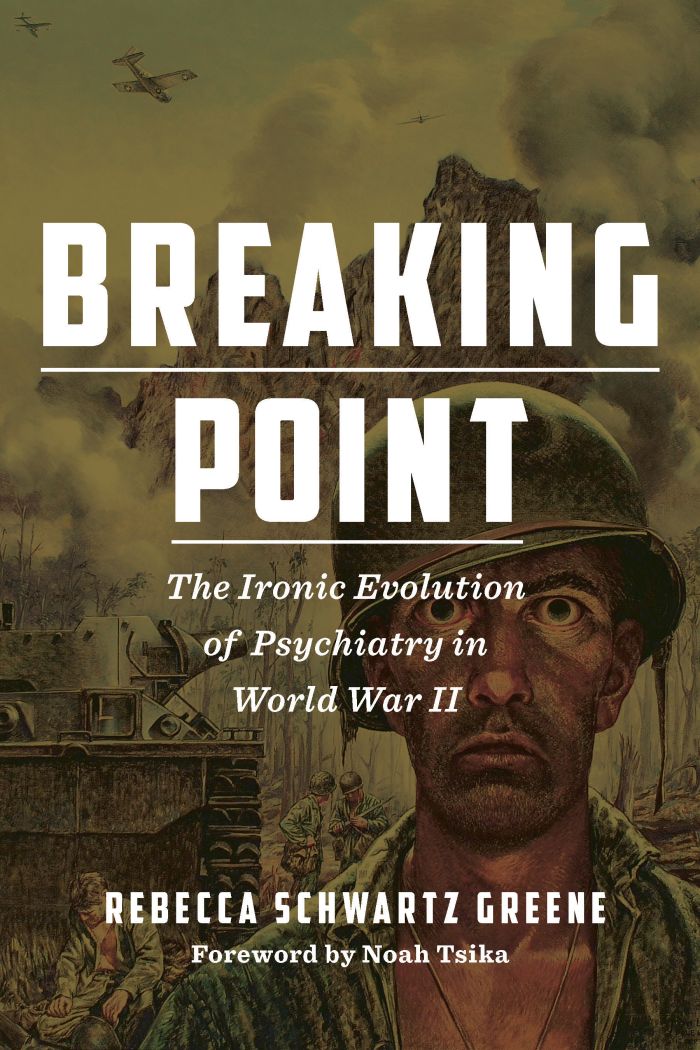Breaking Point
The Ironic Evolution of Psychiatry in World War II

This book can be opened with

WINNER, SOCIETY FOR MILITARY HISTORY DISTINGUISHED BOOK AWARDS - FIRST BOOK
This book informs the public for the first time about the impact of American psychiatry on soldiers during World War II.
Breaking Point is the first in-depth history of American psychiatry in World War II. Drawn from unpublished primary documents, oral histories, and the author’s personal interviews and correspondence over years with key psychiatric and military policymakers, it begins with Franklin Roosevelt’s endorsement of a universal Selective Service psychiatric examination followed by Army and Navy pre- and post-induction examinations. Ultimately, 2.5 million men and women were rejected or discharged from military service on neuropsychiatric grounds. Never before or since has the United States engaged in such a program.
In designing Selective Service Medical Circular No. 1, psychiatrist Harry Stack Sullivan assumed psychiatrists could predict who might break down or falter in military service or even in civilian life thereafter. While many American and European psychiatrists questioned this belief, and huge numbers of American psychiatric casualties soon raised questions about screening’s validity, psychiatric and military leaders persisted in 1942 and 1943 in endorsing ever tougher screening and little else. Soon, families complained of fathers and teens being drafted instead of being identified as psychiatric 4Fs, and Blacks and Native Americans, among others, complained of bias. A frustrated General George S. Patton famously slapped two “malingering” neuropsychiatric patients in Sicily (a sentiment shared by Marshall and Eisenhower, though they favored a tamer style). Yet psychiatric rejections, evacuations, and discharges mounted.
While psychiatrist Roy Grinker and a few others treated soldiers close to the front in Tunisia in early 1943, this was the exception. But as demand for manpower soared and psychiatrists finally went to the field and saw that combat itself, not “predisposition,” precipitated breakdown, leading military psychiatrists switched their emphasis from screening to prevention and treatment. But this switch was too little too late and slowed by a year-long series of Inspector General investigations even while numbers of psychiatric casualties soared.
Ironically, despite and even partly because of psychiatrists’ wartime performance, plus the emotional toll of war, postwar America soon witnessed a dramatic growth in numbers, popularity, and influence of the profession, culminating in the National Mental Health Act (1946). But veterans with “PTSD,” not recognized until 1980, were largely neglected.
From the creation of the psychiatric exam for draftees and volunteers to the use of hypnosis and other therapies to treat casualties of combat exhaustion and fear in North Africa, Europe and the South Pacific, and what would later be called PTSD, Breaking Point exposes the conflicts and compromises among American psychiatrists in World War II. Anchored in extensive research, including interviews with military psychiatrists from that war, Rebecca Schwartz Greene provides a path-breaking account of the successes, failures, and ironic contributions of American psychiatry during World War II and in the post-war popular culture.—John Whiteclay Chambers II, Distinguished Professor Emeritus of History, Rutgers University, and editor-in-chief of The Oxford Companion to American Military History.
Rebecca Greene’s Breaking Point is a signal achievement, providing, for the first time, an accessible history of World War II psychiatry and the lengths to which the US government went to prevent and mitigate the “unseen wounds” of combat. Breaking Point is essential reading not only for historians of World War II, but for anyone concerned at all with the human costs of war, borne in minds as well as bodies, shielded for the most part from public view, and not unique to this conflict certainly as the rate of suicide among veterans of the Iraq and Afghanistan wars, tragically and alarmingly, attests.—Edward J.K. Gitre, Assistant Professor of HIstory at Virginia Tech, and project director and editor, The American Soldier in World War II
. . . [A] first stop for scholars wanting to do further research on particular aspects of psychiatry at war. Greene's work is (still) the most focused account of American psychiatry and World War II.
By giving equal attention to both the successes and failures of psychiatry in this era, Greene's Breaking Point provides a solid, well-researched piece that benefits a wide audience, from the scholar to the general reader. With World War II veterans, as well as psychiatric professionals, passing away in increasing numbers, Greene's book serves as an invaluable source, preserving the experiences of the era with much-needed context of the state of the field in the following conflicts and up to the present day.
[Greene] has done a commendable job, pulling together published and unpublished material, including first-person accounts and personal interviews. . . This author has undertaken a painstaking and groundbreaking research process, producing an "instant classic," but one that will be read and cited for decades to come. Highly recommended.
Rebecca Schwartz Greene brings to light intricate details of the history of psychiatry in WWII, describing its numerous faults, setbacks, and occasional victories, and how they led to a stunning rise in prominence of the field of psychiatry, broadly expanding the role psychiatry played in society, marking this as a moment where the field began to define an expertise in a much wider array of ailments, and began searching for treatments to help heal wounds of war, which in turn influenced the assessment and treatment or anxiety, depression, etc. She provides an essential narrative and perspective on the history of military psychiatry and psychiatry generally.
. . . [T]his book's greatest achievement is that it will force readers to grapple with a tension baked into all military medicine—between physicians' Hippocratic Oath to prioritize individual care, on the one hand, and the pressure to serve the wartime state, on the other.
Rebecca Schwartz Greene is Visiting Scholar at Seton Hall University in South Orange, New Jersey. She is a historian who specializes in American social history, history of medicine, and modern American history.
Noah Tsika (Foreword By)
Noah Tsika is a professor of media studies at Queens College, City University of New York. He is the author of Traumatic Imprints: Cinema, Military Psychiatry, and the Aftermath of War, among other books.
List of Illustrations | ix
Foreword by Noah Tsika | xi
Preface | xv
Introduction | 1
Part I: Before the War
1. Mobilizing for War | 13
2. Military Necessity Overrides Psychiatric Skepticism | 34
3. Debating Screening’s Viability | 46
Part II: During the War
4. Psychiatric Policy Making in the Throes of War | 77
5. The Public Reaction | 101
6. The Response of Psychiatrists | 120
7. The Horrors of War and Beginnings of Change | 138
8. From Prediction to Prevention | 153
9. Limits to Prevention and Treatment | 177
Part III: After the War
10. Return to Normalcy | 209
11. From “War Man” to “Peace Man” | 232
Conclusion | 247
List of Acronyms and Abbreviations | 253
Principal Physicians and Social Scientists | 255
Appendix A: Medical Circular No. 1 | 275
Appendix B: Circular Letter No. 19 | 277
Appendix C: Key Investigations of Military Psychiatry | 279
Acknowledgments | 281
Notes | 287
Select Works | 405
Index | 441




